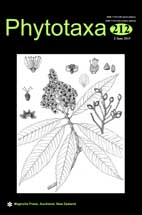Abstract
The Smilax china complex (Smilacaceae) is a typical mixoploid species complex including five extant diploid taxa with a widespread distribution across eastern Asia. The diploid population (mHB, 2n = 32), which was originally considered to be diploid S. china, together with two newly discovered diploid populations (mZZ and mYXS) is supported here as a distinct species by morphological, karyotypic and molecular data. These three populations present consistent morphological characters of sub-erect stems, rudimentary tendrils and minutely serrulate leaf margins, in which they differ from S. china. Molecular phylogenetic analyses also confirm its monophyly with a closer relationship to the other two erect species S. biflora and S. trinervula in the complex. These three populations are thus proposed to be a clear new diploid species and described with the name of Smilax microdontus Z. S. Sun & C.X. Fu, sp. nov. The discovery of this new species highlights the importance of closer examinations on species complexes by integrating multiple evidence.

